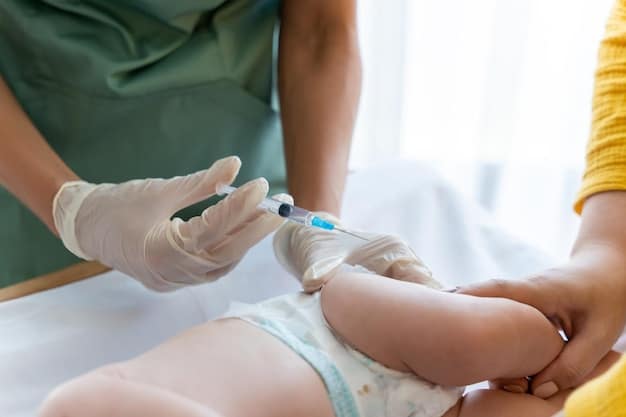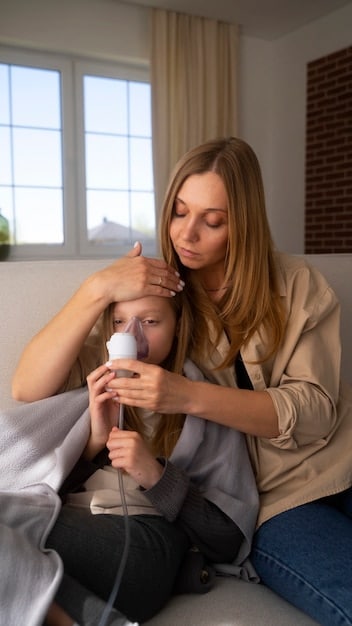RSV Prevention 2025: A US Family Guide to Respiratory Health

The Latest on RSV Prevention: What US Families Need to Know for the 2025 Season involves understanding new preventive measures, recognizing symptoms, and knowing when to seek medical care to protect infants and young children.
As we approach 2025, understanding The Latest on RSV Prevention: What US Families Need to Know for the 2025 Season becomes crucial for protecting our youngest family members from respiratory syncytial virus (RSV). Let’s explore how to stay informed and prepared.
Understanding RSV: Key Facts for US Families
Respiratory syncytial virus (RSV) is a common respiratory virus that affects people of all ages, but it poses the greatest risk to infants and young children. Understanding its characteristics and impact is the first step in effective prevention.
For families in the US, awareness of RSV’s seasonal patterns and transmission methods is crucial for minimizing infection risks. Let’s delve into some key information about RSV.
What is RSV and How Does it Spread?
RSV is a virus that causes infections of the lungs and respiratory tract. It spreads through respiratory droplets when an infected person coughs or sneezes. These droplets can land on surfaces or be inhaled directly.
Additionally, RSV can spread when someone touches a contaminated surface and then touches their face, especially their eyes, nose, or mouth.
Who is Most at Risk?
While anyone can contract RSV, certain populations are at higher risk for severe illness. These include:
- Premature infants
- Young children with chronic heart or lung conditions
- Infants and young children with weakened immune systems
- Older adults, especially those with underlying health conditions
Parents and caregivers should be particularly vigilant if their child falls into one of these high-risk categories. Taking extra precautions can significantly reduce the risk of severe complications.
In conclusion, understanding RSV’s transmission and risk factors empowers families to take proactive steps toward prevention.
New Preventive Measures for the 2025 Season
As we approach 2025, several new preventive measures are emerging to combat RSV. Staying informed about these advancements is essential for families aiming to protect their loved ones.
These new methods offer additional layers of protection, complementing existing strategies like frequent handwashing and avoiding close contact with sick individuals.

Monoclonal Antibody Treatments for Infants
One significant advancement in RSV prevention is the use of monoclonal antibody treatments. These treatments provide infants with antibodies that help their bodies fight off the virus.
Nirsevimab is a key example, offering longer-lasting protection compared to previous options. This can be especially beneficial for infants during their first RSV season.
RSV Vaccines for Expectant Mothers
Another groundbreaking preventive measure is the introduction of RSV vaccines for pregnant women. These vaccines, administered during pregnancy, allow mothers to pass protective antibodies to their babies before birth.
This passive immunity can safeguard newborns during their most vulnerable period, providing crucial protection against severe RSV infections.
Staying Updated with Medical Guidelines
Keeping abreast of the latest medical guidelines and recommendations is vital. Healthcare providers are the best source of information on when and how to utilize these new preventive measures.
- Consult with your pediatrician about monoclonal antibody options for your infant.
- If you’re pregnant, discuss the RSV vaccine with your obstetrician.
- Follow public health advisories and recommendations as they are updated.
By staying informed and consulting with healthcare professionals, families can make the best decisions regarding RSV prevention for their children.
These new preventive measures offer hope and improved protection against RSV, making it easier for families to navigate the respiratory virus season with confidence.
Recognizing RSV Symptoms in Children
Early recognition of RSV symptoms is crucial for timely intervention and care. Understanding the common signs and symptoms can help parents and caregivers respond quickly.
While RSV often presents as a mild cold, it can escalate into more severe respiratory issues, particularly in infants and young children. Here’s what to watch for:
Common Symptoms of RSV
The initial symptoms of RSV typically resemble those of a common cold. These may include:
- Runny nose
- Cough
- Fever
- Decreased appetite
These symptoms usually appear within a few days after exposure to the virus.
When to Seek Medical Attention
It’s essential to know when RSV symptoms warrant a visit to the doctor. Seek medical attention if your child experiences:
- Difficulty breathing or rapid breathing
- Wheezing
- Bluish skin color (cyanosis), especially around the lips and fingertips
- Severe cough
These signs can indicate a more severe infection requiring medical intervention.
Differentiating RSV from Other Respiratory Illnesses
RSV symptoms can sometimes be confused with other respiratory illnesses, such as the common cold or flu. However, certain signs can help differentiate RSV:
- RSV often causes more pronounced wheezing, especially in young children.
- Babies with RSV may show signs of irritability and feeding difficulties.
- Severe cases of RSV can lead to bronchiolitis or pneumonia.
If you’re unsure whether your child has RSV or another illness, it’s always best to consult with a healthcare provider for an accurate diagnosis and appropriate care.
Prompt recognition of RSV symptoms enables families to seek timely medical care, potentially preventing severe complications and ensuring the best possible outcome for their child.
Home Care Strategies for Mild RSV Cases
For mild cases of RSV, home care strategies can provide comfort and support for your child’s recovery. These strategies focus on relieving symptoms and ensuring your child stays comfortable.
Remember, while home care can be effective for mild cases, it’s essential to monitor your child closely and seek medical attention if their condition worsens.
Managing Fever and Discomfort
Fever is a common symptom of RSV. To manage it effectively:
- Administer acetaminophen (Tylenol) or ibuprofen (Motrin) according to your doctor’s recommendations.
- Ensure your child stays hydrated by offering plenty of fluids.
- Dress your child in light clothing to help lower their body temperature.
Keeping your child comfortable can significantly ease their recovery process.
Relieving Nasal Congestion
Nasal congestion can make it difficult for your child to breathe and feed. Try these strategies:
- Use a nasal saline spray to loosen mucus.
- Gently suction the nasal passages with a bulb syringe, especially before feeding or sleeping.
- Run a humidifier in your child’s room to add moisture to the air.
These techniques can help clear nasal passages and improve your child’s breathing.
Ensuring Adequate Hydration and Nutrition
Hydration and nutrition are vital for supporting your child’s immune system during an RSV infection:
- Offer frequent small amounts of fluids, such as breast milk, formula, or electrolyte solutions.
- If your child has a decreased appetite, don’t force them to eat, but continue to offer nutritious options.
- Avoid sugary drinks, as they can worsen dehydration.
Proper hydration and nutrition can aid your child’s body in fighting off the virus and speeding up recovery.

Effective home care strategies can significantly alleviate the discomfort associated with mild RSV cases, promoting a smoother recovery for your child.
Protecting High-Risk Individuals in Your Family
Protecting high-risk individuals from RSV requires extra vigilance and proactive measures. Understanding their vulnerability and implementing appropriate strategies can significantly reduce their risk of infection.
These individuals, including premature infants, children with chronic conditions, and older adults, are more likely to experience severe complications from RSV.
Enhancing Hygiene Practices
Rigorous hygiene practices are crucial for minimizing RSV transmission. Emphasize the following:
- Frequent handwashing with soap and water for at least 20 seconds.
- Using hand sanitizer with at least 60% alcohol when soap and water are not available.
- Avoiding touching your face, especially your eyes, nose, and mouth.
These habits can help prevent the spread of RSV and other respiratory viruses.
Limiting Exposure to Sick Individuals
Reducing contact with sick individuals is essential for protecting high-risk family members:
- Avoid close contact with people who have cold or flu-like symptoms.
- Keep children with RSV away from high-risk individuals, if possible.
- Consider wearing a mask in crowded places or when interacting with potentially infected individuals.
Limiting exposure can significantly reduce the risk of RSV transmission.
Creating a Clean Home Environment
Maintaining a clean and sanitized home environment can help prevent the spread of RSV:
- Regularly clean and disinfect frequently touched surfaces, such as doorknobs, light switches, and countertops.
- Ensure good ventilation by opening windows regularly.
- Use air purifiers with HEPA filters to remove airborne particles.
A clean home environment can minimize the presence of the virus and reduce the risk of infection.
By prioritizing hygiene, limiting exposure, and maintaining a clean environment, families can effectively protect high-risk individuals from the dangers of RSV.
The Role of Vaccination in Future RSV Prevention
Looking ahead, vaccination holds a significant role in future RSV prevention efforts. Ongoing research and development are expected to produce even more effective vaccines and strategies.
As new vaccines become available, understanding their benefits and potential impact will be crucial for families seeking comprehensive RSV protection.
Current RSV Vaccine Developments
Several RSV vaccines are currently in development, targeting different populations:
These vaccines are designed to stimulate the immune system and provide protection against RSV infection.
Potential Impact of Widespread Vaccination
Widespread RSV vaccination has the potential to significantly reduce the burden of the virus on healthcare systems:
- Decreased hospitalizations and severe illness among infants and young children.
- Reduced transmission rates within communities.
- Improved overall respiratory health outcomes.
Broad vaccination efforts could lead to a healthier future for all.
Staying Informed About Vaccine Recommendations
Staying informed about the latest vaccine recommendations is essential for making informed decisions:
- Consult with healthcare providers about the availability and suitability of RSV vaccines for your family.
- Follow updates from public health organizations, such as the CDC and WHO.
- Be aware of any potential side effects and benefits associated with vaccination.
In the future, vaccination will likely play a central role in RSV prevention, helping to safeguard communities and protect vulnerable individuals.
| Key Point | Brief Description |
|---|---|
| 👶 Monoclonal Antibodies | Nirsevimab offers extended protection for infants. |
| 🤰 Maternal Vaccines | Vaccines for pregnant women pass immunity to newborns. |
| 🤧 Recognize Symptoms | Early detection is crucial for timely intervention. |
| 🏠 Home Care | Manage fever, congestion, and ensure hydration for mild cases. |
Frequently Asked Questions (FAQ)
RSV is a common respiratory virus that can cause severe illness, especially in infants, young children, and older adults. Premature babies and those with heart or lung conditions are particularly vulnerable.
RSV spreads through respiratory droplets when someone coughs or sneezes. It’s most common during the fall and winter months. Frequent handwashing and avoiding close contact with sick individuals can help prevent spread.
Symptoms include runny nose, cough, fever, and sometimes wheezing. Seek medical care if your child has difficulty breathing, bluish skin, severe cough, or high fever, as these can indicate a severe infection.
New preventive measures include monoclonal antibody treatments like nirsevimab for infants and RSV vaccines for pregnant women. These options provide enhanced protection against severe RSV infections.
Protect your family by practicing good hygiene, limiting exposure to sick individuals, creating a clean home environment, and consulting with healthcare providers about available vaccines and antibody treatments to reduce the risk.
Conclusion
Understanding The Latest on RSV Prevention: What US Families Need to Know for the 2025 Season empowers families to proactively protect their loved ones, especially infants and high-risk individuals. By staying informed about new preventive measures, recognizing symptoms early, and implementing effective home care strategies, you can ensure a healthier, safer year for your family.





